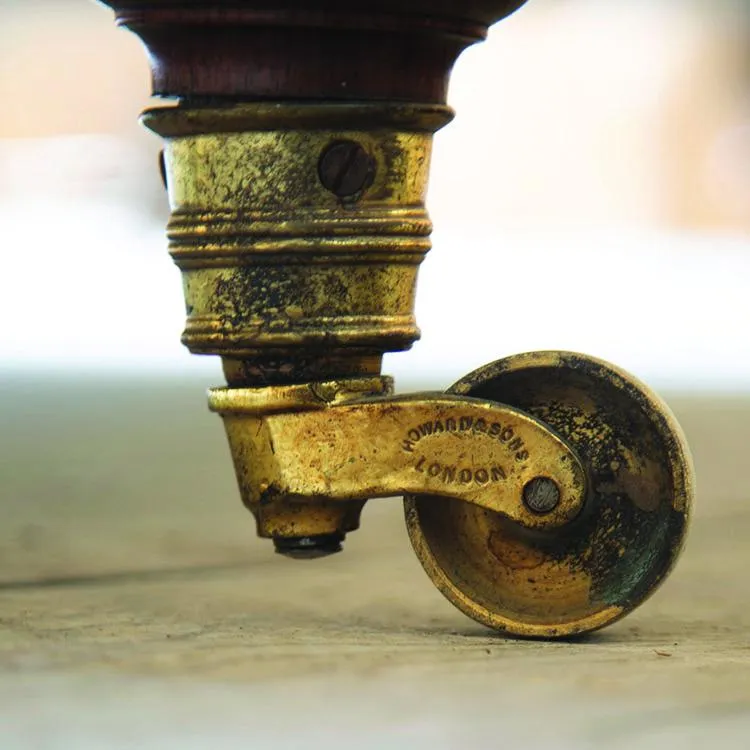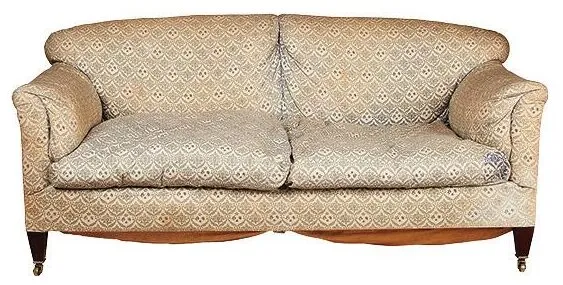There is nothing like it. The proportions, the styling, how it makes you feel…’ says James Thorpe of Wimbledon Furniture, explaining the unique appeal of an antique Howard & Sons armchair. Although it would have been made 100 to 140 years ago, he says, it will still be more comfortable than many equivalent pieces made today.
Established in 1820 by cabinetmaker John Howard, Howard & Sons quickly became one of the best-regarded furniture makers of the 19th century. In its infancy the company’s repertoire was much more extensive than the sofas and chairs for which it is now known. In Victorian England, an ‘upholsterer’ or ‘upholder’ covered a wide number of jobs. An old trade card for John Howard offers expertise in parquet flooring, wallpaper hanging and even coffin lining.
By the mid 1840s, as the company moved its workshops around the Whitechapel area, upholstery became its focus. Howard & Sons eventually settled in Berners Street, in London’s West End. By this time, John’s eldest son, George, was increasingly involved in the business and in 1851 he was noted as the principal upholsterer.
Although upholstered furniture was not a new concept at that time, Howard & Sons certainly redefined it. Giles Bray of Middleton-Bray Upholstery has dedicated much of his career to studying Howard & Sons, having been impressed by an early Howard armchair he was asked to restore. ‘I took great care over the restoration,’ he recalls. ‘And I realised, while working on it, that the exceptional quality of the frame and the formation of the feather and down cushions attached over a sprung foundation was quite unlike anything I had seen up to that point.’
With great skill and imagination, Howard & Sons achieved a level of comfort that far exceeded anything that had gone before, and this was down to two inventions. First came the ‘elastic seat’, which was patented by George Howard in 1866. This invention totally upended traditional upholstery, as the use of coil springs in the seat allowed for movement up and down as well as side to side.

The height of luxury, however, was achieved through the ‘siège de duvet’ construction. ‘This enabled a down-filled cushion to be fixed permanently to the upholstery frame in a hidden way, with the under-springing and quality horsehair keeping the cushion permanently lofted in feel and appearance,’ explains Giles. ‘Prior to this invention, feather and down cushions were loose and had to be shaken by hand to achieve comfort.’
Aside from its revolutionary seats, Howard & Sons is also admired for its frames. ‘The edges of all the inner wooden rails are chamfered to prevent wear on the materials, which is very rarely seen in other furniture,’ says Giles. ‘With the investment in tenon machinery, Howard was able to employ this structural advantage at a sensible price over its more zealous competitors, who stuck to handmade production, which ended up making their products too expensive.’
Victorian design was influenced by the controlled, and sometimes rigid, style of the previous Regency period. Howard & Sons broke this mould. ‘Word quickly spread through the wealthier elements of society that a Howard armchair or sofa was the must-have item for one’s country or city house,’ says Giles. This reputation was bolstered by advertising, and listings for Howard chairs still survive from publications such as Tatler, Vanity Fair and The Illustrated London News. As their reputation grew, the company went from strength to strength, and by the early 1900s it had 250 employees on its books.
In 1935 Howard & Sons was bought by decorating firm Lenygon & Morant, who continued to create furniture to the original designs and traded as Lenygon & Morant makers of Howard Furniture. ‘My father, George Webb, was hired as an upholsterer in the 1960s and ended up running the place,’ says Chris Webb, explaining the company’s more recent history. ‘You end up being part of the furniture here – no one tends to leave.’ Chris now co-owns the company with his father and, along with their staff, they have years and years of experience between them. Sofas and chairs are made to plans drawn up in the 1900s and for some designs the original cutting sheets are still used. ‘It’s all bespoke. We can add 2cm here or there to the height or the width,’ Chris says, and it’s not uncommon for customers to order ‘his and hers chairs’.

For purists, however, only a pre-1935 chair will do. Douglas Girton leads the furniture department at Lyon & Turnbull and notes a very strong market for genuine Howard & Sons pieces. ‘I don’t believe traditional taste or a sense of style and comfort will ever go out of fashion, and that is the core appeal of this furniture,’ he explains. It’s unsurprising, then, that interior designers are frequently asked to source antique Howard armchairs and sofas for clients. Aficionados dream of finding antique examples in good, original condition, with the iconic monogrammed ticking well preserved. But a genuine Howard piece is so collectable that condition can be overlooked. ‘You can refresh the feather and down inserts and underlying padding, and change the outer covers, but it is the essential quality of the frames that makes them what they are,’ says Douglas.
Chris Webb warns that not all so-called antique Howard sofas and chairs are what they seem. He recently challenged a seller on eBay who had listed a chair as being 100 years old. ‘But from the stamp, serial number and the initials,’ Chris says, ‘I knew it had been made by me!’
The easiest way to determine whether or not you have a genuine Howard piece is to start with the legs. ‘When I’m visiting a client, you’ll often find me on my hands and knees pulling up slipcovers to check for the tell-tale Howard & Sons stamps on the legs and castors,’ says Douglas Girton. These stamps often include an address, which helps to determine the period. You will also sometimes find paper labels sewn into the hessian of the frame.

Country salerooms can be a good source of Howard pieces but, if you can’t wait for the antique chair of your dreams to turn up at auction, you can always order something bespoke from the company’s London showroom.
Iconic Howard & Sons models
Bridgewater
A late 19th-century example of the classic button-back Bridgewater armchair in modern upholstery, with a company stamp on the rear leg, sold for £2,125 at Lyon & Turnbull.

Portarlington
With the company’s stamp on the frame and upholstered in Howard & Sons’ monogram-print fabric, this c1900 Portarlington sofa sold for £16,250 at Lyon & Turnbull.

Wing back
This generously proportioned wing back chair, c1870–90, has been re-covered in a block-printed calico and sold at Lorfords. The all-important Howard & Sons stamp is on the leg
